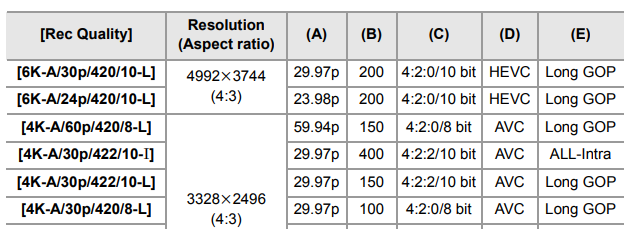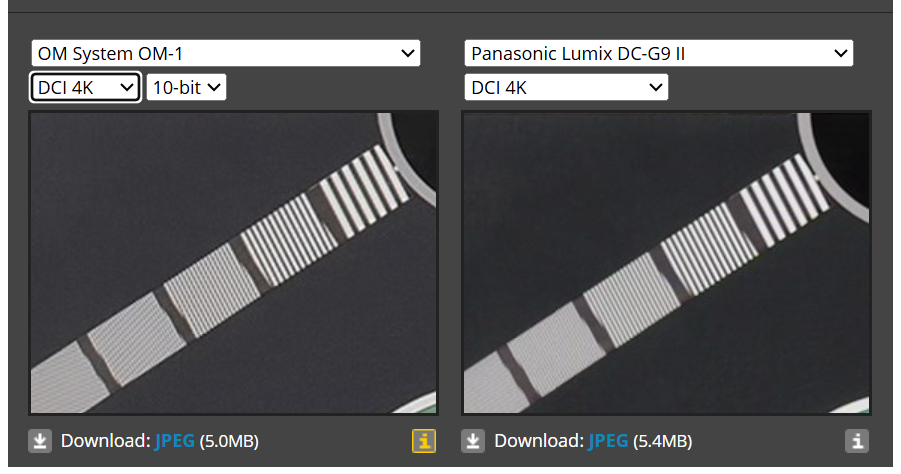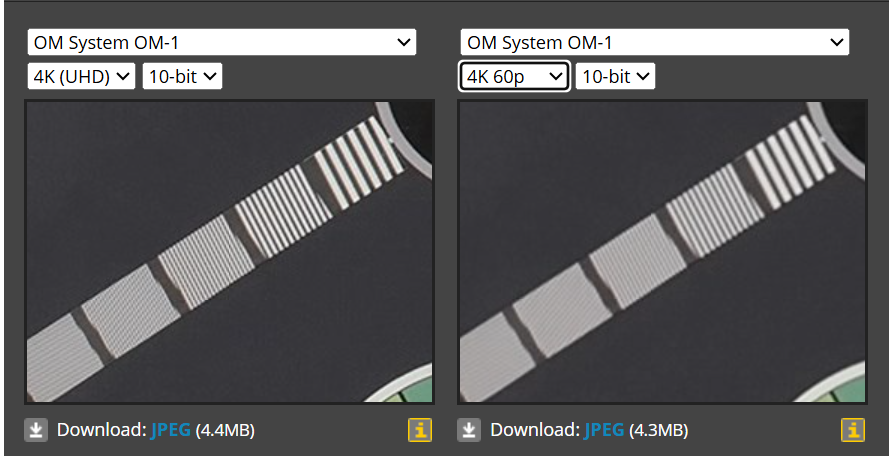
ac6000cw
Members-
Posts
683 -
Joined
-
Last visited
Content Type
Profiles
Forums
Articles
Everything posted by ac6000cw
-
Panasonic Lumix G7 vs. S5II, used as camcorders
ac6000cw replied to John Matthews's topic in Cameras
AFAIK, up to at least 60p, the GH5/GH5ii/GH5s/G9/GH6/GH7/G9ii read out the whole sensor width and sufficient height to allow high-quality re-sampling/processing down to (e.g.) FHD and UHD, which probably helps with moire suppression. And yes, the high pixel density versus lens resolution also helps (plus diffraction softening at smaller apertures). I like reasonably chunky grips too - it's a major reason why I've never bought an E-M5 iii or OM-5 (and bought used E-M1 ii and iii instead, despite the larger size and weight). I've got a Sirui grip for the S9 (which is deeper than the SmallRig version), but if I've got the 20-60mm kit lens on it I don't add the grip as there's enough lens barrel to sit nicely in my left hand. The grip is useful with the 18-40mm lens though. -
Note the link embedded in the first post is partly fake, so I assume it's a scam post from a new user.
-
Panasonic Lumix G7 vs. S5II, used as camcorders
ac6000cw replied to John Matthews's topic in Cameras
I skipped over the G7 and went from G5 to G6 to G80, but I shot some of my favourite footage with the G6 in Standard profile at 1080p50 (28Mbps AVC) - the highest quality it could shoot. There was definitely something about the image that those older 16MP sensor cameras had, which seemed to have got lost in the G80 (despite it having nominally the same 16MP sensor). But eventually I decided I could live with the size and weight of a G9 and entered a whole better world of image quality and stabilisation performance... Comparing the G9 and my recently acquired S9 - I think 4k50p on the G9 is much less prone to aliasing/moire and the sharpening isn't overdone, but the stabilisation is better on the S9 (as is the dynamic range handling in difficult conditions). Otherwise, which one I might choose to take out would depend far more on lens choices and overall kit size/weight for what I was intending to do - either can produce excellent video (my abilities are more the limiting factor!). (Straying away from Panasonic, if I was forced to choose just one camera to keep and use out of my current collection, it might be the OM-1, but only because it has a blend of abilities that fit my preferences and needs combined with 'good enough' video quality). -
Camera prices – Have the Japanese taken leave of their senses?
ac6000cw replied to Andrew - EOSHD's topic in Cameras
A few interesting quotes from the BCN web page where the chart orrginates from (my bold): Nikon is basically going for a 'pile it high and sell it cheap' strategy in the full-frame MILCs - but as the last to enter that market, they probably don't have much choice when up against Canon and Sony (Panasonic is almost a niche player but could easily suffer collateral damage from the battle). -
Camera prices – Have the Japanese taken leave of their senses?
ac6000cw replied to Andrew - EOSHD's topic in Cameras
Not me, but that's mostly because every time, over the years, I've considered buying one of their MILCs the cons have outweighed the pros (for my use cases). So I've stayed completely with M43 cameras (mostly Panasonic) until very recently, when I bought an S9 as a smaller and lighter 'general use' alternative to my OM-1 and G9. I seriously considered an A6700 instead, partly because it has an EVF, but the better IBIS/stabilization of the S9 (and its recent heavy price reduction in the UK) swung it that way eventually. I'm a 50fps shooter normally (not for slo-mo, to get less compromised motion handling), so I regard the S9 as basically an APS-C video camera, hence comparing it to the A6700. Fuji are ruled out for me as they don't support plug-in power for external mics, and AFAIK Canon and Nikon don't currently have anything in that size/shape with IBIS. But I'm probably an outlier here, as I'm a 'video' person through and through, rather than a 'film' person 🙂. -
I think it's derived from the full sensor area. But I don't think it's really comparable with the S1 ii no-crop 5088 x 3392 3:2 at 60p. Neither of them can manage the full sensor resolution (S1ii 6000x4000, GH5 5184 x 3888) at 60p.
-
Are you sure about that - the manuals for the GH5 and GH5ii don't mention it, 4:3 '6K-A' is only available up to 29.97 fps? If you want 59.94 fps 4:3 then it's 3328 x 2496 maximum.
-
The first stage of large S9 price drops in the UK started in February - I bought an S9 as soon as it happened, as I'd been interested in getting one for a while. In my case it was a red S9 + 18-40mm kit for around £1100 in 'like new' condition. With further price drops about a month ago that kit is now about £1200 new. I quite like it - nice solid-feeling body, decent battery life and with the 18-40mm a fairly compact kit (for a full-frame camera). Not quite a modern GX80, but close enough for most of my use cases. My main criticism is probably that, for a camera presumably aimed at new/inexperienced users, there's too much of the higher-end video stuff cluttering up the menus with options and choices they probably won't understand or ever use. Sure, you can use filtering, My List, customise the 'quick' menu and set up custom mode dial presets to simplify things - but you've got to understand what the options mean in order to set those up.... Why not split the video bitrate/fps/frame size/codec options into 'basic' and 'advanced' sets out-of-the box? And when you press the 'record' button in photo mode, default it to shutter priority with 180 degree shutter angle, instead of 'P' mode with variable shutter speed/angle (but that is a historical Panasonic issue/feature going back many years - at least the 'flicker decrease' workaround for it is still in the menus).
-
dpreview's 'review in progress' is up - https://www.dpreview.com/reviews/panasonic-lumix-dc-s1ii-review
-
I agree.
-
In the UK the new S9 body price dropped to £999 at the end of March, and used prices are heading towards £800 (MPB have a couple at £829 at the moment). Just after the recent price drop, I found a red 'used like new' S9 + 18-40mm kit from Amazon for about £1100 and took the plunge (I fancied a non-black camera body for a change). I quite like it overall - feels nice and solid in the hand, and the lack of a grip isn't as much of a problem as I thought it might be. I agree it urgently needs more small lenses - the 18-40 zoom is OK as far as it goes, but everything else Panasonic offers is large and/or expensive in comparison with the body. As a travel zoom the 28-200 makes sense, but new it costs almost as much as the body and used prices are almost as high as there's not many around. Weirdly Panasonic don't offer that as a kit with the S9 - surely it's an obvious kit for the full-frame 'travel cam' market?
-
Yes, having been a happy user of the 14-140mm F3.5-5.6 for over a decade (I'm on my 2nd copy after my 10 year old original got too much dust inside), it's a great travel/everyday lens. Problem is that Panasonic don't make a modern equivalent of the GX85/GX9 to create the perfect travel combo for video with Dual-IS and no-crop 4K...
-
The OM-1's strength is as a good handling, relatively light weight, handheld run-and-gun camera with very low rolling shutter. and decent AF. I think it's video quality is more than good enough for that kind of use (which is basically what I use it for), but TBH I don't think it's a camera you'd choose to put on a tripod and shoot a feature film with.
-
I've found that in video C-AF, if a lens is stopped down to a small aperture, the OM-1 (and the E-M1 ii/iii) will sometimes decide it's not quite in focus and pulse it to check. If the lens has low focus breathing it's often not noticeable as the depth-of-field at small apertures hides it. But it means lenses with low focus breathing are a good idea if using C-AF in video. Oly/OMS cameras don't have an AF-lock function, but you can assign the MF (manual focus) function to a button, which basically does the same thing (provided you don't touch the lens focus ring!). Also the AF-ON button can be used to force a re-focus in both C-AF and MF modes. So in MF mode, pushing AF-ON to get initial focus then tweaking it with the lens focus ring if necessary is easy. What video 'IS Level' are you using (-1, 0, +1) and is this in M-IS 1 (with digital) or M-IS 2 (sensor shift only) mode? At the +1 setting it will be jerky if you move it too fast (It's intended for static hand-held situations), but -1 and 0 settings should be OK for normal movement (in my experience).
-
In pictures of the bottom of the FX30, it doesn't look like it has a cable hole for a dummy battery. AFAIK the FX30 can be powered over USB-C from a PD-capable charger or power bank (the manual states 9V at 2A is the minimum spec). Otherwise just buy some more batteries. As MrSMW suggested, if you choose carefully (in my experience) decent 3rd-party batteries can be almost as good as the OEM ones and are normally much cheaper (but avoid the really cheap ones - they are cheap for a reason...).
-
Nikon would doubtless say you should buy one of our more expensive cameras with a CF Express Type B card slot... This is a low-cost camera (in today's full-frame market), so I'm not surprised it's limited to UHS-II SD cards.
-
I agree the low-contrast/low-saturation look seems to be fashionable at the moment - and I don't like it either. It's not accidental that the 'standard' settings of cameras (and TVs) usually have relatively high contrast and saturation - it makes the images look attractive and eye-catching. What sort of film would 'The Third Man' be without its high-contrast monochrome imagery, or 'Goldfinger' without the glitzy look? Out of interest, was the choice of GH7 versus the 'sister' smaller and lighter G9ii down to the internal 4k ProRes recording and fan cooling/longer recording times on the GH7?
-
Where is this sensor performance data coming from? It looks like you're quoting it from a website somewhere.
-
It means 'SuperSpeed' i.e. USB3 at 5 or 10 Gbit/s (the plastic parts of the connectors are also often colored blue). For reference 'High Speed' USB is 480 Mbit/s and 'Full Speed' USB is 12 Mbit/s. Note that while some USB-C connectors and cables support 'SuperSpeed', not all do (cheap cables in particular often don't support more than 480 Mbit/s). The 'SuperSpeed' connection uses separate wires in the cable, and it's cheaper to leave them out. So if buying a cable, check carefully that it supports SuperSpeed (5 or 10 Gbit/s) data rates if you need them. In my experience, most PC/Laptop USB-C ports are SuperSpeed-capable but peripheral devices to plug into them are a complete mixture of speed capability. Personally, no, but I almost always buy Sandisk or Samsung, and always 'sold by Amazon' i.e. not from marketplace sellers. I've never needed to buy a UHS-2 card, so no advice on that.
-
From dpreview's video test chart, OM-1 vs G9ii (both at 24p/25p/30p) - they are very close on resolution/sharpness: ....but on OM-1 is 50p/60p much softer than 24p/25p/30p - note the softness of the middle bar at 60p vs 24p/25p/30p : Those test results match what I've found when using the OM-1 for real-world video.
-
It is - provided you hold the camera reasonably still, otherwise you get jerks if you move it too fast. It's the mode I normally use for wildlife video with that lens. The extra crop that digital stabilization adds is actually useful in that situation too.
-
Yes, probably more than you really need - and sometimes several ways of doing the same thing (but annoyingly there are a few things that would be really useful to assign to a camera function button but you can't...). Photo and Movie modes are (mostly) separate worlds, including the function button settings.
-
If anyone is interested, this is a comparison I did of various OM-1 IBIS settings and Panasonic 'Power OIS' lens stabilization. All handheld, all C4K@50p video, using Panasonic 100-300mm f4.0-5.6 II lens at 100mm and 300mm. I was standing still, the camera was handheld, using the EVF, with my left hand underneath the lens and right hand holding the camera body.
-
It's also got a 4-stop ND filter:





